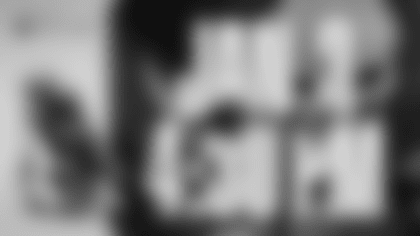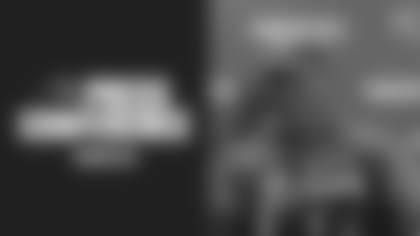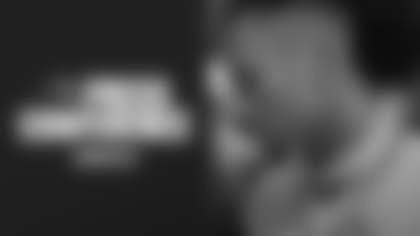Hello. Please allow me to introduce myself.
I am the Tampa Bay Buccaneers' Answer* Man.*
If you've been a regular visitor to Buccaneers.com since at least 2004, this may be more of a re-introduction. See, this isn't my first go-around on the world wide interwebs.
From 2004-07, I wrote a regular column for Buccaneers.com (okay, it became a little irregular towards the end, which may be why I was, ahem, reassigned by my bosses here at One Buccaneer Place). In it, I did my best to answer questions sent in by Buc fans regarding all things Buccaneer and the NFL. Team history, rules interpretations, statistics, miscellany...if I knew the answer I printed it for everyone to read, along with the original question and the questioner's name and hometown. And if I didn't know, I did my best to find out. I got a little deeper into the NFL rulebook than I ever would have imagined (I imagine I'll soon be rediscovering how dry of a read that is) and a lot deeper into wacky what-ifs than I had expected.
But it was fun. Much more fun than what I've been doing for the past three years. Turns out I don't really have a knack for day-trading. Or Alaskan crab fishing. Or crime scene investigation. Or plumbing. Fortunately, the Answer Wife has rich parents.
While I was gone, however, there was apparently a survey on the Buccaneers.com message board about features our visitors would like to see on the site, and one was...I'm really blushing right now!...the return of the Answer Man! Really? Little old me?! Little old me and my incredibly wordy, rambling, 10,000-word columns?
So I got the call from One Buccaneer Place, dropped my pipe wrench in about two seconds flat and raced back to the only workplace I've ever loved. I hope you all have some good questions, so I can keep this job for awhile.
I did have a little time, during my hiatus, to get a makeover, as long-time visitors to Buccaneers.com have probably already noticed. Click here to see my old look. I'll wait. ... Are you back? Yeah, it was probably time for a change. As fun and positive as most of the question-submitters were back then, I took an awful lot of abuse about my appearance. My chin was a particularly fertile source for jokes. You might be looking at my new picture and thinking, 'Can't be the same guy.' Well, haven't you ever read superhero comics? Taking off the mask does wonders. Heck, all Clark Kent had to do was take off his glasses and nobody recognized him.
Okay, you don't have to say it. No, I'm not a superhero, even if I used to pretend to be one. But I am the guy with the answers (hopefully) to your questions. So if you've got something you've always wondered about your team or the sport in general (why are quarterbacks always licking their fingers? See below), fire away. You can send me a question now, tomorrow or any day of the week by clicking here.
One note that I always have to emphasize whenever I get back to answering questions: Please understand that I am not here to offer my opinions on what the Buccaneers have done or should do? I won't be able to tell you who we are going to take in the first round of the draft, or even who I think we should take. I'm not going to comment on lineup decisions or salary cap management (though I'd be happy to tackle nuances of how the cap works, and have done so many times before).
Also, I have an extensive archive of all my previous articles right here. I don't expect you to go through all of them to see if your question has been answered before, but I may at times refer you to previous answers rather than rehash old ground. Also, you might find those old columns to be interesting reads; I hope so. To give you a taste, and also as an example of the types of questions I usually find myself answering, I've grabbed a handful of previous questions and answers, pretty much at random, and reprinted them below.
I hope you enjoy them, and maybe they will inspire you to send in a question of your own.
**
Questions from the Answer Man Archive:
1. Brenda Robinson of Fort Worth, Texas asked:
Why do quarterbacks lick their fingers all the time and, if there's any way to find out, who was the one who started this rather filthy habit?
Answer Man: Who started the finger-licking business? Who knows? That kind of thing isn't really recorded in NFL history.
It's no mystery what it's all about, however: Grip. Quarterbacks lick their fingers because they believe it gives them a better grip on the ball. Some wipe sweat off their faces for the same effect. The Buccaneer QB we asked - we'll leave him nameless since you think the habit is so filthy - says the full maneuver is to lick the fingers, then wipe them on the towel. That way, you get the extra 'tack' without the fingers being slippery.
None of that was any great revelation. However, this passer did clue us in to a little detail about finger-licking that we hadn't thought of before. Namely, if you're going to lick your fingers, you have to do it before every snap, not just the ones on which you're about to throw. Otherwise, the defense will notice you doing it and know the coming play is a pass.
That's the value of experience.
**
- Carlos Escobedo of Atlanta, Georgia asked:
Okay, we can all see that the trade for Joey Galloway worked out well for the Buccaneers. The guy's a stud, and I guess you could say the team killed two birds with one stone on that one.
My question is, how often do trades like this work out? It doesn't seem like there really is a lot of trading in the NFL, and I can't remember the last big-time contributor the Bucs got in a trade...maybe Thomas Jones. I think I recall we got him in a trade. Okay, maybe my question is, what is the best trade the Bucs have ever made, in terms of getting a player? Is it Galloway? What's the best trade overall, considering all the implications? What's the worst deal, if you're willing to answer that one? You're Mr. Research...go back into the archives and tell us how the Bucs have done at the swap meet.
Answer Man: Oh, now that is a rich topic, Carlos, and excuse me for saying so but you didn't really define too clearly how you want me to approach it. It is true that trades are relatively uncommon in the NFL when compared to, say, MLB or the NHL. Still, that's relatively uncommon. The Buccaneers' media guide lists hundreds of trades over the years, though many ended up being relatively minor.
Besides separating the major ones (two first-round picks for Keyshawn Johnson) from the minor ones (a 12th-round pick for Joe Ferguson), you can put the trades into four basic categories:
1. Player(s) for player(s). These are the rarest kind, which was what made the Galloway-Johnson trade something of a surprise at the time. The Bucs have actually pulled off two such deals in the last three years, also snaring RB Thomas Jones from Arizona for WR Marquise Walker (uh, that was a win). Before that, though, the previous two player-for-player trades executed by the Bucs were P David Leaverton-for-WR Jonathan Pittman in 2002 and CB Roderick Jones-for-DE Jim Skow in 1990. If you don't remember which two players the Bucs got in those deals, you get an idea of how earth-shaking they were (for the record, the Bucs got Leaverton and Skow for Pittman and Jones).
2. Pick(s) for player(s). These are somewhat more common, if only because teams often fall into a situation where they are determined to move a player (Keenan McCardell) and the obvious return is a draft pick. The most recent such trade for the Buccaneers was the acquisition of QB Luke McCown for a sixth-round pick during last year's draft. The last time the Bucs traded a player to get a pick was the McCardell deal, which netted third and sixth-round picks in 2005.
3. Draft positioning. These are by far the most common, as teams move up and down in the draft in order to grab a particular player or pick up extra selections. Few drafts go by without the Bucs doing this at least once. Last year, they traded down a bit in the fifth round and got an extra seventh out of it, which they eventually used on safety Hamza Abdullah.
4. Special circumstances. I added this one basically to cover such deals as the four draft picks the Bucs sent to Oakland in 2002 in order to get the rights to hire Head Coach Jon Gruden. A deal like this recently went down between Kansas City and the New York Jets for Herman Edwards; we could call them "compensation" trades.
There are, of course, combinations of these deals. A team might trade a player and a pick in order to move up in the draft, for instance, such as when the Bucs sent FB Darian Barnes and their seventh to Dallas in 2004 in order to move up 10 spots in the final round and grab WR Mark Jones. Or two teams might swap players, but one side has to sweeten the deal with a draft pick on their end. In 1983 the Bucs sent T Charley Hannah to the Raiders and got DE Dave Browning back, plus a fourth-round pick.
The Bucs have had (sometimes spectacular) successes and failures in each category. Let's see if I can distill your letter into a series of straightforward questions, then provide answers as best I can.
Is the 2004 trade for Joey Galloway the best trade the Bucs have ever made, in terms of getting an established player?
Well, my first answer is "too soon to tell." Galloway has played, basically, a season and a half for the Bucs so far, so that's just not enough evidence yet. However, I think it's fair to say that his acquisition already ranks up there among the best, with the chance to finish on top.
Without getting into the specifics of each deal, here are some other established players that the Bucs have netted through trades down through the years: RB Thomas Jones (2003); WR Keyshawn Johnson (2000); QB Eric Zeier (1999); FB Lorenzo Neal (1998); S Thomas Everett (1994); LB Jimmy Williams (1992); LB Jesse Solomon (1991); RB Gary Anderson and QB Chris Chandler (1990); S Mark Robinson and LB Eugene Marve (1988); QB Steve DeBerg (1984); QB Jack Thompson (1983); DT Wally Chambers, TE Jimmie Giles and TE Jim Obradovich (1978); QB Steve Spurrier, CB Mike Washington and LB Richard Wood (1976).
A few quick observations off that list.
One, most of those deals worked out for the Buccaneers, but usually just for a short period of time. Players like Everett, Williams and Anderson were near the ends of good careers, and they gave the Bucs a season or two before retiring. The most notable players that did not work out in the list above were quarterbacks, particularly Chandler and Thompson. More on that later.
Two, Giles might be the most accomplished player on that list, so you could say he's the best answer to the above question (with apologies to Johnson, Robinson, DeBerg and, especially, Washington and Wood). However, was the trade to acquire Giles a complete home run? The Bucs loved everything about the Galloway trade, since they were sending Dallas a player they no longer wanted on the team (though Johnson has continued to succeed for the Cowboys, so they probably like the deal, too). But to get Giles from Houston the Bucs traded down from the first overall pick in 1978 to the 17th pick, and also picked up three additional picks (a second in 1978 and a third and a fifth in 1979). The Oilers used the first overall pick to select eventual Hall-of-Famer Earl Campbell, while the Bucs' four picks netted QB Doug Williams, G Brett Moritz, DE Reggie Lewis and QB Chuck Fusina.
The Bucs got almost nothing out of Moritz, Lewis and Fusina, a total of 35 games played and no starts between them. So the end result of the deal was Doug Williams and Jimmie Giles for Earl Campbell. The trade certainly worked out for both teams - Williams and Giles emerged as two of the best players in franchise history - but it's hard to call that deal a no-brainer if you were making it today.
The Bucs gave up a third-round pick to get Mike Washington and a seventh-round pick to get Richard Wood. Both players stayed with the team for nine seasons and were key members of the league's number-one ranked defense in 1979, when the Bucs first made the playoffs and advanced all the way to the NFC Championship Game. Washington started 97 games for Tampa Bay, Wood 89. Washington is tied for third on the Bucs' all-time interceptions list; Wood is fourth on the career tackle chart. Galloway may eventually be the best answer to the above question, but for now the Answer Man will have to go with Washington and Wood.
What is the best trade the Bucs have ever made, period?
Again, the Galloway trade makes it into the discussion, and is only likely to get better. But the Answer Man is going to have to hedge on the answer just a bit, because there was a closely-related series of trades in 1995 that is my pick for the top of the list.
First, some honorable mentions, in no particular order.
1. In 1996 and 1998, the Bucs eagerly agreed to trade second-round picks to San Diego for the Chargers' first-round picks in 1997 and 2000, respectively. The Answer Man says you do the deal any time a team comes calling, unless you have your heart dead set on a player who is surprisingly available to you in that current round two. The Chargers used those two second-round picks on WR Bryan Still (1996) and WR Mikhael Ricks. Still never got much of a career going and Ricks bounced around the league for awhile, eventually converting to tight end. The Bucs used their extra first-rounder in 1997 on WR Reidel Anthony and their extra first-rounder in 2000 to package with their own first-rounder to get Keyshawn Johnson.
2. Lo Neal for a fifth-rounder in 1998 was a steal, considering Neal's iron-headed blocking helped lead the Bucs to the fourth-best rushing attack in the NFL that year. The Bucs were 11th the year before and 15th the next year, after Neal had departed. The returns on that one didn't last long, but were very noticeable.
3. The Colts gave Tampa Bay a first-round pick in 1996 in order to get Craig Erickson. The Bucs were going to go with Trent Dilfer and they used that first-round pick on Marcus Jones. Considering Erickson's relatively short stay with Indianapolis, that deal worked out very well.
4. The Bucs traded down seven spots in the second round with Buffalo in 1987 and still got CB Ricky Reynolds, while the Bills wanted CB Nate Odomes. Both players worked out well for their teams and the extra fourth the Bucs picked up was used on TE Ron Hall, who became a Tampa Bay mainstay for years.
5. The aforementioned Washington and Wood pickups. The Bucs also traded S Cedric Brown to Oakland in 1977 for sixth and ninth-round picks. That deal worked because not only did the Bucs get two relatively useful players with those picks in QB Gary Huff and WR Larry Mucker, but they also got Brown back at the start of the 1978 season after he was cut by the Raiders. Brown went on to start 95 games for the Bucs and intercept 29 passes, second-most in franchise history.
6. This one almost takes the cake: In 1995, the Bucs traded tight end Harold Bishop to Cleveland for a high second-round pick. Now, Bishop had been drafted by the Bucs in the third round the year before, but hadn't really worked out, playing in just six games without a catch. Somehow, they were able to move him a year later for that second-rounder, which eventually also made it easier to trade their own second-round pick to the Chargers in that deal mentioned above. Bishop would last just two seasons with the Browns/Ravens, making 18 catches. Now, class, can anyone tell me who the Bucs drafted high in the second round in 1996. Exactly, Mike Alstott. Enough said.
But the best Buccaneer trade, in the Answer Man's opinion, was actually a series of deals made on the first day of the draft in 1995.
Heading into that draft, the Bucs were set to pick seventh in the first round and fifth in the second round. The needs on defense were glaring, and the Bucs had targeted a few players they believed could be special. When Tampa Bay's time on the clock came around, the phone lines were burning. Philadelphia wanted to move up to take, as it turns out, NFL Scouting Combine star Mike Mamula, a defensive end. The Bucs obliged by sliding back to 12th and throwing in a third-round pick in order to get two extra second-round picks from the Eagles.
DT Warren Sapp, a dominant player on the college level, fell into their laps at 12 when Minnesota opted for Florida State DE Derrick Alexander. As the first round progressed, the Bucs noticed another player they coveted, Florida State LB Derrick Brooks, dropping due to a perceived lack of size. Now armed with three second-round picks, the Bucs packaged the first and third of them together to get Dallas' first-round pick, the 28th overall. That's where the Bucs nabbed Brooks.
With their remaining second-round pick, the Bucs selected Kentucky S Melvin Johnson, who had two seasons as a starter before being traded to Kansas City.
To recap, the Bucs somehow turned the seventh, 38th and 69th picks into the draft into the 12th, 28th and 43rd and ended up with the cornerstones of their soon-to-be-dominant defense, plus an additional starter. That was a fine day of dealing.
What is the worst trade in Buccaneer history?
It's not the Answer Man's style to dwell on the negative when it comes to my own team, but I suppose we can touch on this briefly. We should point out that every team has a bad deal or two in its past. There are no guarantees in this business of trading, so every now and then one's best-laid plans are going to go awry.
It's safe to say the Bucs would like to rescind those first-round-pick trades they made to get Thompson and Chandler, two quarterbacks that were supposed to solidify the position but never really worked out. Chandler has had a respectable NFL career, of course, but his two years in Tampa (1990-91) in competition with Vinny Testaverde for the starting job were contentious and rarely fruitful. The worst part was, the pick to get Chandler ended up being the second one overall in the 1992 draft. Indy actually ended up with the first two picks in that draft, a gold mine that famously didn't work out as well as expected when the Colts took DT Steve Emtman and LB Quentin Coryatt.
A couple other deals were basically forced by strife between player and team, such as the trade of G Sean Farrell to New England for a second-round pick in 1987. The Bucs used that pick on Mississippi State RB Don Smith, who failed to make much of an impact. The same was true when LB Hugh Green was shipped to Miami midway through 1985 for first and second-round picks in 1986. The Bucs might feel better about that one if those picks hadn't been used on CB Rod Jones and LB Kevin Murphy.
The deal that sticks out, though, as particularly damaging was the shipment of a first-round pick in the 1983 draft to Chicago for a second-round pick in 1982. At the time, the Bucs were enthralled with Bethune-Cookman DE Booker Reese, and felt he had been worthy of a first-round pick. It's probably safe to say now that he wasn't; Reese played just three seasons in Tampa and started seven games.
Now, that Buccaneer pick in 1983 ended up being 18th overall, because Tampa Bay made the playoffs in 1982. However, as you might recall, that was a particularly deep draft, especially at quarterback. Yes, that was the John Elway/Todd Blackledge/Jim Kelly/Tony Eason/Ken O'Brien/Dan Marino draft. Other players in that first round included RBs Eric Dickerson, Curt Warner and Gary Anderson, G Bruce Matthews, Ss Gill Byrd and Joey Browner, CB Darrell Green, Ts Chris Hinton and Jimbo Covert, C Don Mosebar and DE Jim Jeffcoat. The Bears used the Bucs' pick on WR Willie Gault.
Yeah, that would have been a good draft in which to have a first-round pick. Perhaps the Bucs, having just lost Doug Williams to the USFL thanks to a contract dispute, would have gotten in on that quarterback run. After all, O'Brien went 24th and Marino, amazingly, went 27th.
Instead, the Bucs felt compelled to trade their 1984 first-round pick to Cincy for Thompson. That worked out so well that a year later the Bucs traded for DeBerg. Meanwhile, they had no first-round pick for the second year in a row, helping lead to a talent drain, which was exacerbated in 1986 when RB Bo Jackson, taken first overall, chose to go play baseball instead. The Bucs would have been picking first overall in 1984, but the pick eventually ended up in New England's hands and was used on WR Irving Fryar.
So, what do you think, Carlos? Did I provide your answer somewhere within all of that? Next time send a more focused question and you'll get a more focused answer. (Well, probably. I'm not promising anything.)
**
- Wess Jacobs of Fort Myers, Florida asked:
Why do we run the ball on 1st down every time? Pittman off guard for two yards, Pittman off tackle for no gain, incomplete pass, punt.
I pulled that part out, Wess, because it didn't ring true to me. I wasn't sure that I agreed that the Bucs overwhelmingly tend to favor the run on first down. So I went through several of the play-by-plays to see if I was right.
I don't know, but I would suspect that your feeling on this issue stems from the last game, Wess. With a 10-point lead in the fourth quarter, the Bucs were running on almost all downs. That's a common strategy when the clock is a team's main enemy; it's called a four-minute drill, and the Bucs did it successfully in their first game against New Orleans, a win.
It's fair to include last Sunday's game in our study, but we should also include several other games to cover different types of situations. I picked four games, including last Sunday's loss. That one covers the situation of the Bucs being ahead in the second half. I picked the Oakland game because the opposition was ahead in the second half. And I picked two games where neither team was well ahead at any point, two games that went down to the wire. One was a Buc loss - at Carolina - and one was a Buc win - at home against Kansas City.
I then charted all the first-down play calls by both teams in those four games. I included plays that were fully executed but then erased by penalties because, after all, it's the play call that we're concerned about here.
Here's what I found:
- New Orleans (12/19)...The Bucs ran the ball on 19 of 25 first downs, averaging 6.1 yards per carry on those 19 runs. The Saints ran the ball on 14 of 24 first downs, averaging 2.2 yards per carry.
- Oakland (9/26)...The Bucs ran the ball on 10 of 28 first downs, averaging five yards per carry (that average is skewed in the Bucs' favor by a 32-yard run by Mike Alstott on the last play of the game). The Raiders ran the ball on 18 of 33 first downs, averaging 6.8 yards per carry.
- Carolina (11/28)...The Bucs ran the ball on 15 of 29 first downs, averaging 2.0 yards per carry. The Panthers ran the ball on 11 of 23 first downs, averaging 4.1 yards per carry.
- Kansas City (11/7)...The Bucs ran the ball on 11 of 28 first downs, averaging 2.5 yards per carry. The Chiefs ran the ball on 15 of 34 first downs, averaging 1.9 yards per carry.
Interpret those numbers as you like. That's not an exhaustive study, but it seems like a pretty representative cross-section of games.
And it appears to the Answer Man that there is no clear pattern of favoring the run on first down overwhelmingly. Only in the New Orleans game, in which the Bucs had a lead for most of the second half and had their most productive rushing game of the season, did the Bucs run on significantly more than half of their first down plays.
There is a concept in sociology called the "confirmation bias," which postulates that we tend to selectively notice evidence that supports the things we already believe or want to be true, while ignoring evidence that would seem to contradict our beliefs.
I'm not saying that specifically to you, Wess...I don't know how closely you've actually looked at the numbers or even if you are right or wrong in your belief, despite the bit of research above. It would be unfair of me to make any such assumptions about your feelings, or to suggest that you are wrong to be frustrated. I bring it up because I know that I am guilty of the confirmation bias all the time. I'm sure every fellow driver on my way home from work is not driving like a maniac or an idiot, but when I get home, I sure don't remember seeing any calm, respectful drivers.
Sports are an emotional business and we evaluate them emotionally. That's not a bad thing, it just is. But it doesn't always lend itself to objective analysis.
The point? This has most definitely been a disappointing season for the Buccaneers, but the run-pass ratio of play-calling on first down is probably not the reason why, in my humble opinion.
**
4. Danny of Clearwater, Florida asks:
Dear Answer Man, If a punt is blocked by the receiving team, and the kicking team catches the ball that was blocked, can the player of the kicking team now run it for a first down?
Answer Man: Alright, here we go! A good, old-fashioned rulebook question. I was beginning to think y'all didn't care about crazy scenarios anymore. Remember when we used to do whole columns on stuff like this?
This is a relatively easy one, Danny. The answer is yes, as long as the kicking team recovers the ball behind the original line of scrimmage. If a punt is blocked but still goes over the line of scrimmage, then it still behaves like any other punt. That means that a member of the kicking team can recover the ball, but all he will be doing is downing it at that spot. It would still be the receiving team's ball, first down.
I think what you're asking, however, is what can be done when the punt is blocked and it remains in the kicking team's backfield. At that point, yes, anyone on the kicking team can pick it up and run with it. In fact, the punter could pick it up and throw for a first down (to an eligible receiver) if he so desired.
Let's look in the rulebook under Rule 9, Section 1, Article 1. Here's a scenario described by the book:
A.R. 9.1...The kicking team's punt is blocked and the kicker picks up the ball behind the line of scrimmage and throws a forward pass to end A1.Ruling: Legal play (8-1-1).
That 8-1-1 notation, by the way, simply refers to Rule 8, Section 1, Article 1, which is about legal forward passes.
**
5. Matt of New Port Richey, Florida asks:
OK... to complete the list of possibilities and beat the failed PAT/conversion to death officially...
Say Jay Taylor kicks a PAT attempt, and it is blocked. Can a Buccaneer then pick up the loose ball and run it into the end zone for 2, providing the defending special teams unit does not gain possession?
Answer Man: I agree with the sentiment of your opening line, Matt. We have beaten this one into critical condition.
You've given us a new scenario, sort of, but the answer remains the same as before: Once a kick is clearly not going to be good, the extra point attempt is over. When Taylor got blocked, the play ended and it didn't matter where the ball went. This is noticeably different from the rule for punts we discussed above.
So that you believe me, I'll reprint a portion of Rule 11, Section 3, Article 1:
(a) If a Try-kick is good, one point is scored. (The conditions of 11-5-1 must be met.) If a kick cannot score, the ball becomes dead as soon as failure is evident.
Rule 11-5-1, by the way, runs down the criteria for a field goal or extra point to be good - not touching the ground after the kick, the whole ball passing through the goal, things like that.
Furthermore, the book describes your scenario in an example in this same section:
An attempted Try-kick is blocked. Offensive A1 recovers behind the line and advances across the goal line or recovers in defensive's end zone. Ruling: No score in either case. The ball is dead as soon as its failure as a kick to score a Try is evident.
Now, Chad below comes at this same question from a slightly different angle, and we do see a way for a player on a kicking team to score two points.
**
- Graysen Marker of Ft. Myers, Florida asked:
O.K., here it is: I know that this isn't necessarily about the Bucs, but I was wondering how the teams of the NFL were separated into conferences, and if it's random, then how were the original teams' conference placement decided?
Answer Man: That's two questions out of the first three originating in Ft. Myers, and that got the Answer Man to thinking. Notice that Eli sent it in as Fort Myers while Graysen chose Ft. Myers. I'm gathering that either usage is acceptable, but I'm wondering if there is one that is preferred. I usually see it written as Ft. Myers (along with Ft. Lauderdale and Ft. Pierce). However, the official Fort Myers web page spells it out. Is this even a debate anywhere, or just in the Answer Man's head?
If you're from Ft. Myers and you're planning to send in a question this week, please add in your thoughts on this critical issue.
On to your question, Graysen. The basic layout of the National Football Conference and American Football Conference in the NFL dates back to the NFL-AFL merger in 1970. However, the NFL had been using the term "conference" for 20 years by that point.
From the league's beginning in 1920 through the 1932 season, there were no divisions among the teams, nor any playoffs. Anywhere from a high of 22 teams in 1926 to eight teams in 1932 competed for roughly 14-16 weeks and the team with the best record at the end was the champion. (By the way, there was a team called the Los Angeles Buccaneers during that bloated 1926 season).
The first playoff game came in 1933. The 10 teams were split into two "divisions," Eastern and Western, and the winners of each division played a single championship game. That year, the Chicago Bears beat the New York Giants, 23-21; fittingly, it was Chicago's George Halas who had helped push through the idea of divisions and a championship game.
The game remained split into those two divisions for decades, though for quite some time "Western" meant places like Chicago, Green Bay and Cleveland. Los Angeles made it a truly Western Division in 1946 and San Francisco joined in 1950 (but so did the N.Y. Yanks, so even then, geographical divisions were often shaky).
Actually, the Yanks are part of the story, which I thought was going to brief and is suddenly getting very lengthy on me. Anyway, a rival league, the All-American Football Conference, began playing with eight teams in 1946, among them Paul Brown's Cleveland Browns. In 1950, the NFL made a partial merger with the AAFC, taking in Cleveland, San Francisco and Baltimore. Also, an existing team named the N.Y. Bulldogs changed its name to the Yanks and divided players from the former AAFC Yankees between its own roster and the N.Y. Giants.
The league was now 13 teams strong, and it remained basically divided on geographical terms, though the two groups were now renamed the American and National Conferences. Cleveland went into the American Conference, which included such former Eastern Division teams as Philadelphia, Pittsburgh and the Giants. San Fran and Baltimore went into the National Conference, along with such Western Division holdovers as the Bears, Lions and Packers.
A few teams came and went, but this setup held together into the '60s, though the NFL went back to calling them Eastern and Western Conferences in 1953. While the NFL played with 14-16 teams in two conferences for most of the '60s, the AFL debuted in 1960 and played the decade with 8-10 teams in two "divisions."
Things started to get really interesting in the middle of the decade, as the NFL fell into a bidding war for top players with the AFL, which played a looser, faster brand of the game. However, a series of secret meetings in 1966 laid the groundwork for a merger between the two leagues, which was eventually approved by Congress and put into effect in 1970.
Before that, in 1967, the two teams began playing an overall championship game against each other, a little contest you might have heard of called the Super Bowl (though it wasn't immediately known as the Super Bowl, of course). Also in 1967, the NFL did a bit of realignment, splitting its two conferences into two divisions each, called the Capitol and Century Divisions in the East and the Coastal and Central Divisions in the West. Fortunately, those goofy names lasted only until the merger.
So, prior to 1970 you had 16 NFL teams in two conferences, arranged mostly by geography, and you had 10 AFL teams in two divisions, also arranged mostly by geography. When the two leagues merged into the NFL as you know it, the league maintained its two conferences but changed the names again, to American and National, or AFC and NFC.
Those two conferences were basically mirrors of the two existing leagues. However, because there were 16 teams in one league and 10 in the other, three original NFL teams had to shift to the AFC. Those three were Baltimore, Cleveland and Pittsburgh.
For the most part, that's how the conferences stand today, with expansion teams generally going into one league or another to keep it balanced. The only real movement from one conference to the other came with the 2002 realignment, when the Houston Texans were added to balance the league again at 32 teams. Seattle agreed to switch from the AFC to the NFC, with Houston taking the 16th AFC spot, and the whole league was juggled a bit to get the geography of the geographical divisions back in line. Atlanta moved from the NFC West to the NFC South, for instance, and Arizona jumped from the NFC East to the NFC West.
So, to get back to my original point, the American and Football Conferences in the NFL are basically products of the AFL-NFL merger of the 1970s. Maybe I should have just left it at that, huh?
























